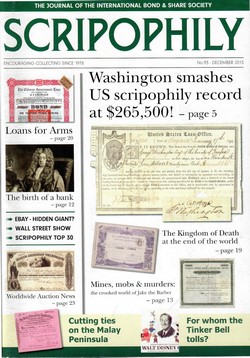
This article appeared in
SCRIPOPHILY
December, 2013
Scripophily is a member benefit of
the International Bond & Share Society.
Visit the IBSS website for info.
Pondering the Big Hoard
The huge Penn Central hoard of American railroad certificates hit the hobby in 1986. U.S. dealer R.M. Smythe & Co. sold off parts of the collection over the next two decades in public auctions as well as through its normal retail and wholesale business. The size of the hoard demanded that Smythe sell large numbers of certificates in multi-item lots. Those kinds of lots often sold to dealers who in turn parceled out certificates in restricted numbers over periods of years. Because large lots tended to go to dealers, the effect of the hoard on the hobby was greatly softened. In that respect, Smythe established the standard for how to sell a hoard without killing the market.
Even if it was inevitable for prices to soften, Smythe’s measured approach to selling managed to keep prices sensible. I have no idea of the number of certificates Smythe sold behind the scenes, but its public auctions maintained an attitude of highest hobby responsibility. To those of us in the general hobby, lists of auction prices realized are the only way we can track those sales and it seems that single, rail-related certificates were modest in comparison to the size of the hoard.
In contrast, we are currently in the middle of the release of a great hoard, but it is not a hoard in the classic sense of coming from one, previously unknown source. The contrast between today’s hoard and that of the Penn Central (and the Northern Pacific hoard that followed) is stark. This “hoard” is coming not from a single source, but from sellers everywhere. Consequently, there is not the slightest hint of pricing and distribution control.
Between Nov. 30, 2012 and Nov. 29, 2013, I recorded 3,300 sales of individual certificates in the railroad specialty alone. Since I do not record any sales below $20, I probably missed a thousand or more cheaper certificates. If we add in all the certificates that sold in mining and other specialties, from the U.S., Germany and elsewhere, the number of certificates hitting our hobby is incredible.
Obviously, I am talking about eBay auctions.
It would be highly informative if we had the statistics to study this release across all specialties, but we don’t. I can only study railroad issues and yet I am very much hampered by incomplete information. Nonetheless, I am seeing an average of four new certificates appear every week, plus equal numbers of new minor variations.
The sheer number of items being offered has depressed prices over the last decade, of course, but those numbers have also enticed numbers of rarities out of hiding that few experts had previously seen. I never noticed a dramatic surge of material, but rather steady and significant numerical growth between 2000 and 2012. I cannot say for sure, but the overall supply of certificates seems to have been stabilizing over the last year. There have always been periods of high and low activity, so any move toward supply stabilization enticingly suggests price stabilization. Possibly even a modest price rise.
Although many of us really hate to admit it, it is obvious that eBay is now part of the fabric of our hobby. eBay now seems to be THE dominant source of low- and intermediate-priced certificates and it is not going away anytime soon. While genuine rarities appear on eBay from time to time, the vast majority of high-value certificates are still sold by professional dealers and auctioneers.
A few professional dealers have always taken advantage of eBay. However, price competition from amateur sellers is so fierce that profitable eBay selling has never proven as easy as it seems
I have never heard of any hard and fast rules for successful selling as part of an unorganized hoard, but professional dealers seem to show that time-proven techniques can help separate them from the crowd. Analysis of my database proves that, on average, amateur sellers seldom attract the prices professionals achieve, even for near-identical items sold on the same day! Attractive, higher-quality scans and better descriptions seem to play a key role, but predictable A-1 service is probably also highly important.
Still, amateurs and pros alike are selling thousands upon thousands of certificates every year and all those certificates are going SOMEWHERE. While the hobby has definitely changed since the appearance of the Penn Central hoard, it still seems rather vibrant to me. I just wonder what it is going to take to reach those buyers and bring them into our organization.
As to where we go from here, I am afraid I don’t have an answer. I cannot say whether the diffuse eBay hoard will dry up or if it will continue forever. I cannot possibly predict where prices will go. I can, however, feel comfortable in suggesting that collectors and dealers alike can use this hoard to their benefit. If collectors are in this hobby for the pleasure of the hunt, then eBay is an excellent source to check every day, not just once a week. And if dealers are in this hobby to make money, there are rarities and bargains to be found almost every day. In my opinion, eBay auctions represent the uncontrolled release of a non-classic hoard, so future directions and outcomes will remain difficult to predict.